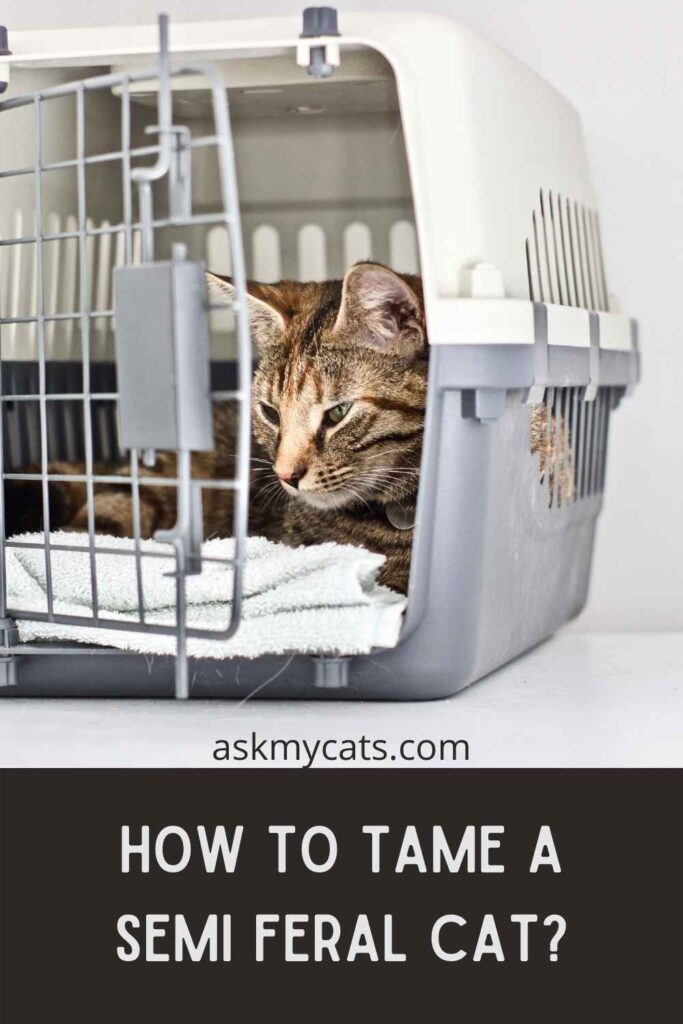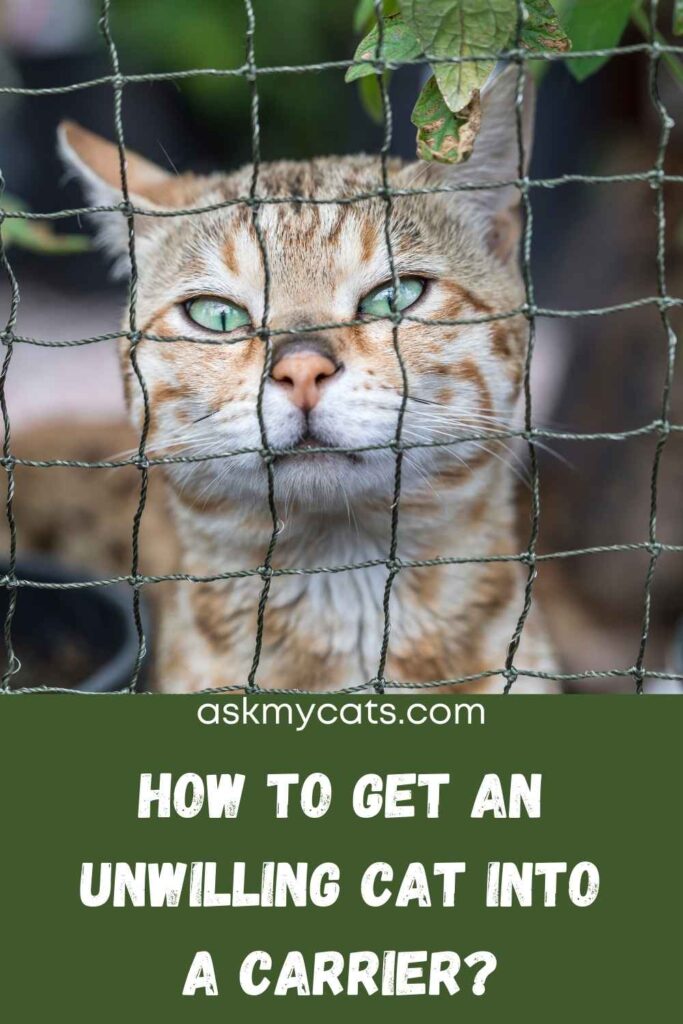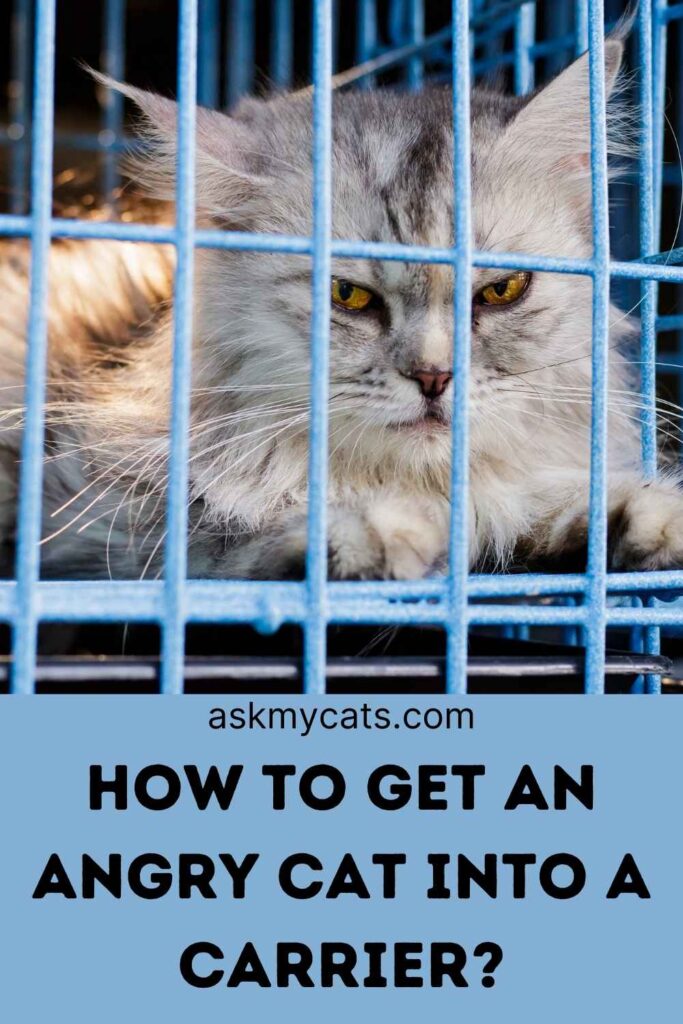Feral cats should not be disturbed. Cats of feral are wild and prefer to hide out. She will be nice to you and allow yourself to feed her, however she needs to be outside.
A wild cat is not to be dressed. When you get her in, she’s still always going to play and take her out and try to abandon most of her life.
If you want to get a semi feral cat in a carrier, prepare the crate in the same place, out of sight of the cat. Sneak up behind them, cover them with a blanket, pick them up, and place them in the crate. It might take a few tries, or it might not fit for ferals.


Give Your Cat the Perfect Day
Get the Free Ebook!
How To Catch A Semi Feral Cat?
If they aren’t too tall or obese, consider grabbing the scruff with one hand and supporting them with the other.
DO NOT pick them up by the scruff alone, without a body support. Since the scruff normally disables them, you cannot be able to get a decent handle on them if they are big.
If you want to get the cat more than once, you may not be able to catch it and it would be agitated. It’s best to put them in a tight spot or a small room.
Be that you’re not in a room with a bed or something else they might crawl under. If the cat is in a room with convenient access to other hiding spots, lock both doors.
Obtain a medium-sized crate and position it on its back end with the door open. Grab the scruff of the cat’s fur. Make sure you have a firm hold on the cat so it can’t escape.
As soon as you catch the cat, place your other hand on the crate to keep it stable, and drop the cat into the crate BACK FEET FIRST, locking the door against your hand.
Release the cat, immediately remove your paw, and shut the door behind you to prevent the cat from escaping.
When you scruff the cat and lower it feet first, it won’t be able to fight back as well and will brace itself against the entrance as you attempt to push it in.
Just get a humane trap and draw them into it, or lure them into a carrier that you can close behind them easily. A hard-sided carrier would be best.
The best draw is food. The distinction between the two is that the carrier form requires you to be present at all times.
One of the feral communities in the area may be able to assist you. If you’ve caught a few, the rest will pick up on it and become more difficult to capture for a while.
You don’t specify whether the cats are inside or outside. If they live with you, a mild sedative hidden in any strong-tasting food may be an option.
If I need to remove his nails, I give him a dose of gabapentin in fish broth.
It’s not a good idea to mess with feral cats. Feral cats are feral creatures that like to spend their time outdoors. She will be polite with you and allow you to feed her, but she prefers to be outdoors.
A wild cat is impossible to tame. If you introduce her into your household, she would most likely behave wild and aloof for the rest of her life and try to leave.
Bringing in wild cats, no matter how pure the reasons, is called inhumane. You should do something called a TNR if you think about her and her welfare.
Trap-Neuter-Trap-Neuter-Trap-Trap-Trap Some people use return to ensure that cats don’t over-breed and abandon kittens everywhere to starve or be euthanized in shelters. You start by trapping the cat with a wild cat trap.
These are available for purchase on Amazon, or you can make your own. Look up how to make a homemade cat trap on the internet. Place the trap near where they normally congregate, and fill it with strong-smelling food from a distance.
It needs a little patience, so it’s normally not that difficult. Cover the cage with a towel until the cat has been captured. This will help the cat relax. Take her to the vet to be spayed or neutered, and get an ear tip put on her.
The cat is not harmed by ear tips and they are painless. This allows other visitors to see that the cat has already been neutered, and if they know better, they will leave her alone. Send the cat to her home after she has stabilised in the veterinarian’s office.
I like seeing wild cats because I am an animal enthusiast. Bringing them in, on the other hand, would only damage the cat. They forget how to fend for themselves after they’ve been brought in and can’t be released back into the wild.
You should TNR her if you want to do something nice with her. Even if wild cats aren’t living in your household, having them around is always entertaining and adorable. You should give them names and, if they allow it, pet them.
Bringing them in and asking them to live a domestic life, on the other hand, would almost certainly cause them to distrust you. It’s better if you TNR her and leave her alone.
How To Tame A Semi Feral Cat?
Semi feral cats are hard to tame and put inside a carrier because they are born in the wilds and show no interest in remaining indoors.

Feral cats have had little or no human interaction and are essentially wild animals, whereas socialised cats are entirely domesticated and relaxed with humans.
Semi-feral cats are in the middle of the spectrum. They prefer not to be approached, but when they are around people, they can vocalise or even make eye contact.
Taming a semi-feral cat is possible, but a long and complicated operation. These six measures will help you make a new fuzzy pet out of that scared neighborhood cat!
Continue to entice her to return for more. The next move is to have non-threatening, relaxed enrichment and ensure that the cat loves spending time with you and returns.
The best way to begin an encounter with a cat, according to feline rescuers, is at mealtime.
Treats and toys can also be included to allow the cat to interact with you one-on-one, according to the experts.
Desensitize her to being around people over time. Remember that a semi-feral cat can find many of the things we take for granted as normal aspects of life to be very scary. Human voices, songs, and the opening and closing of doors will all send a frightened kitty fleeing for the hills.
Use feeding periods to desensitise the cat and demonstrate that you are not a threat by speaking quietly and doing long, careful activities. Respect her personal room.
There’s already work to be done after you’ve brought your new semi-feral kitty into your home. When the cat is overwhelmed, it may be understandably restless and require a hiding spot. This would save her from getting hemmed in.
Providing so much room, on the other hand, can be daunting and lead to problems, particularly with curious kittens. Robinson recommends keeping the animal in a small space with food, water, and a litterbox.
Be sure the room is kitty-proofed by avoiding something delicate or potentially dangerous, such as wires that might be chewed. To assist her with the change, consider a soothing solution.
A relaxing treatment like catnip, pheromone sprays, or relaxing supplements may do the same for your new cat as a hot bath and a cup of herbal tea will do for you on a stressful day.
While certain semi-feral cats can be tamed in a matter of weeks, it normally takes several months, if not a year, for them to fully change their behaviour.
About any cat can be tamed; just remember to be polite, keep to a routine, consider her normal needs, engage with her on a daily basis, and give her plenty of treats!
How To Get An Unwilling Cat Into A Carrier?
You can put an unwilling cat into a carrier by tricking and fooling him to enter into the crate.

If you don’t have at least a few days or longer to focus on slowly reconditioning your cat to go in the crate safely, use the short cat burrito method. That’s the second technique; scroll down to see it.
Though this method is normally very reliable, it takes days to complete, and you might not have that much time. The purrito will help you easily get a cat into a cage, reducing stress and the risk of injuries for both humans and cats.
Our “burrito-cat-into-carrier” method is intended for safe, social cats. If the cat runs following the first try, being in a toilet raises the odds of getting a second chance.
Place the carrier in your bathroom for at least 24 hours until you need to get the cat into it.
Do this while your cat is occupied with something else, such as feeding or playing with someone, or while he is asleep.
Propping the carrier against the closed bathroom so the door is open and facing the ceiling just before going time is a good idea.
When descending your purrito into a hard plastic carrier with just one handle, stand the carrier on its top, angled slightly (imagine the leaning tower of Pisa) so the door does not quickly slam shut, even though you knock it.
This allows you to take advantage of gravity as well as the slick rubber surfaces of plastic carriers.
To make a less slippery surface, drop a bunched up bath mat or towel on the floor under the carrier.
Find a lightweight bath towel that is large enough to wrap around your cat to cover all of his legs, hands, and claws, but small enough to slip through the carrier door wrapped around your cat. Also, place the towel in the shower.
Get the cat and the carrier into the bathroom with you. You may be able to pick up and bring your cat inside, or you may be able to entice him in with food or a toy, depending on your cat. Lock the door quickly.
Cover the cat in the towel like a burrito, with just their head poking out (as far as possible!). It’s possible that you won’t get it right the first time! Cover and grip the towel tightly enough to keep the cat from escaping, but not so tightly that it hurts them or prevents them from breathing.
Lower the burrito cat into the carrier and quickly close the lock, starting with the tail end (so the cat doesn’t see he’s being placed into the carrier). Don’t think about unwrapping the towel; they’ll do it for you.
How To Get An Angry Cat Into A Carrier?
Allowing an angry cat to get acquainted with the carrier for a few days is the safest way to get her into it.
If you don’t have time to do this, you can use a towel, pillowcase, toys, or treats to get the cat into the carrier, as discussed in more detail below.

Most cats are drawn to laser pointers and will go to great lengths to chase the signal using a laser pointer, try catching your pet cat’s eye and then luring them into the carrier by pointing the laser light inside.
Once your cat is inside, immediately close the carrier door so he can’t escape.
Why not use one of your own cat’s favourite cat toys to entice him into the carrier? Toss in some of his favourite toys.
When your cat has finished chasing the toys and entered the carrier, shut the door behind her.
Some people may think this technique barbaric, but it also helps to relax your pet so he won’t be able to see what’s going on around him.
To do this, try to take the cat off balance and easily stuff him into a pillowcase, tying the top so he can’t get out.
Place him in the carrier after calming him down with a substance like Feliway Calming Spray.
Feliway Calming Spray, for example, is an excellent pheromone spray for calming, relaxing, and behaving your pet. Catnip, on the other hand, is a well-known herb for calming cats and improving their mood.
Although it’s understandable for your cat to get agitated and defensive when confined to a carrier, keep in mind that there are things you can do to help him relax and become used to it.
Make it a point to speak to your pet in a soothing voice to motivate him to use a carrier or to stay inside one that he is already in.
When in transit, cover the carrier with a blanket so your pet doesn’t see any of the outside worlds.
Most importantly, you can wash the carrier after a visit to the vet to avoid stressing your cat because the scents left behind in the carrier would most likely equate with something unpleasant, particularly if she was vaccinated or had some painful operation.
Frequently Asked Questions
How do you get a feral cat to come to you?
The Stomach Is the Fastest Way to a Stray Cat’s Heart. Since stray cats are always starving, the safest first step is to feed the cat and have plenty of water. Once the cat realises you’re a food centre, she’ll come every day. This is enough to win the confidence of some really friendly cats.
How long does it take for a cat to turn feral?
A kitten would most likely maintain certain feral traits for the remainder of his life after reaching the age of four months, such as fear of strangers or transition. If a fully adult wild cat actually socialises, it could take years.
Final Words
You may need to place a cat in a holding crate or administer medication to a cat that refuses to take it. Capturing a frustrated or disturbed cat, whether it’s your cat or a stray, can seem unlikely.
Fortunately, there are methods for catching a feline pal without being scratched.
Stop putting food in the cat’s bowl so that it becomes hungry. If you’re still having trouble capturing the cat, try waiting a day or two between feedings so the cat can be hungrier.
Place a trap with food inside in the usual feeding position after the two-day withdrawal cycle. The majority of cats would enter the trap in order to get the food.
Drop your questions in the comments section below!

I have a feral cat who is scared of being caught to be put in his crate I can’t even pick up the cat to hold him. Who can I call in Huntington beach ca to help me catch the cat. That doesn’t charge an arm and a leg
Hello linda,
You can try to get in touch here…
https://www.facebook.com/LostPetsHuntingtonBeachCA/
Happy Cat Parenting